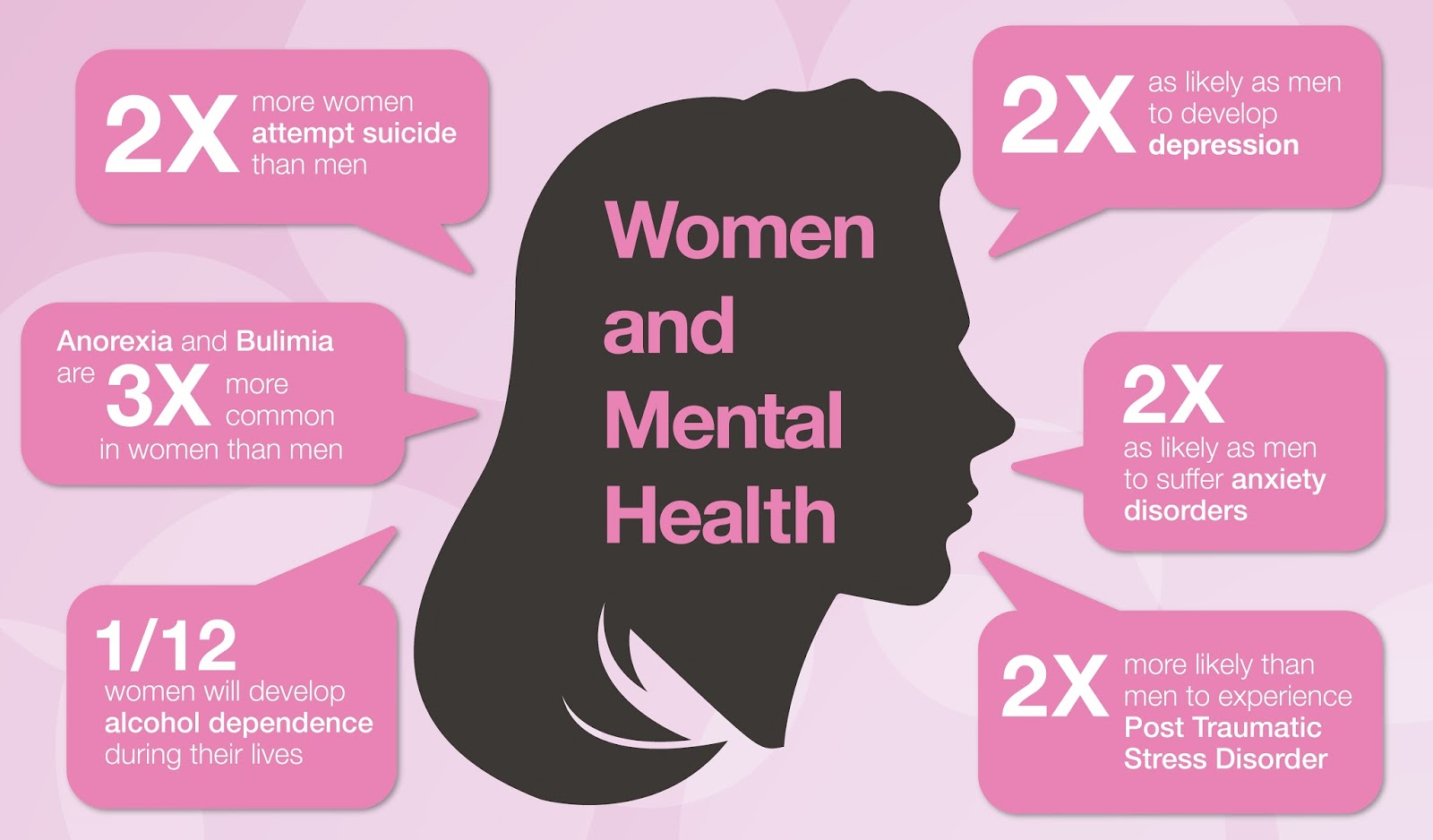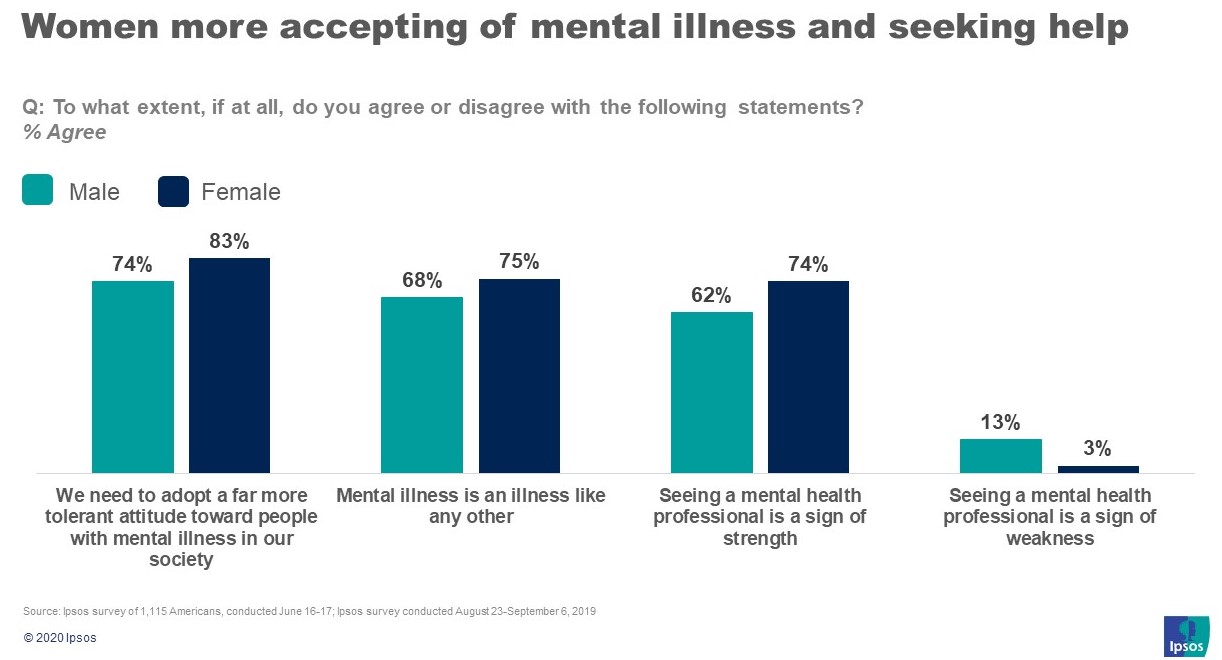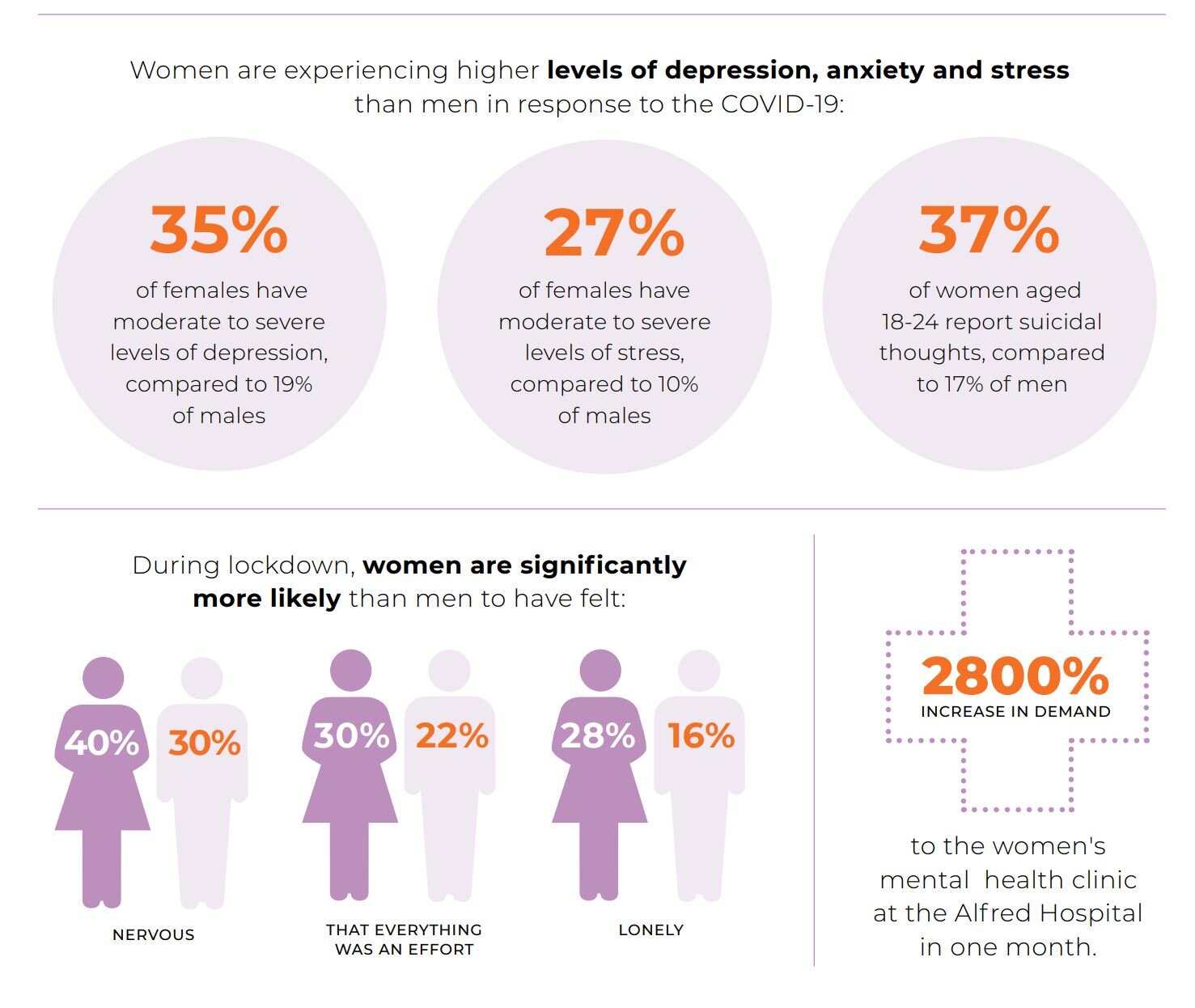Womens Mental Health vs Mens Mental Health
Women’s mental health vs men’s mental health: A seemingly simple comparison, yet it reveals a complex tapestry woven from biological differences, societal expectations, and deeply ingrained cultural norms. This exploration delves into the disparities in prevalence, types of conditions, help-seeking behaviors, and the overall impact on physical and mental wellbeing across genders. We’ll examine how societal pressures, gender roles, and biological factors contribute to these differences, ultimately aiming to understand how we can better support men and women in achieving optimal mental health.
Understanding the nuances of mental health across genders requires looking beyond simple statistics. While certain conditions may be more prevalent in one gender than the other, the underlying causes are multifaceted and often interconnected. We’ll discuss the unique challenges faced by each gender in seeking help, the effectiveness of various treatment approaches, and the long-term consequences of untreated mental illness on both physical and mental health.
The goal is not to create a competition between genders but rather to foster a more nuanced and empathetic understanding of mental health struggles.
Prevalence and Types of Mental Health Issues
Understanding the prevalence and types of mental health issues in women and men is crucial for developing effective prevention and treatment strategies. Significant differences exist in the rates and types of conditions experienced by each gender, influenced by a complex interplay of biological, societal, and psychological factors.
Prevalence of Common Mental Health Conditions
Studies consistently show higher rates of anxiety and depression in women compared to men. For instance, the World Health Organization (WHO) reports a significantly higher global prevalence of anxiety disorders among women. While depression affects both genders, women are more likely to be diagnosed. Conversely, men may exhibit higher rates of substance abuse disorders and antisocial personality disorder, although accurate statistics can be challenging due to underreporting and different presentation of symptoms.
Differences in Types of Mental Health Conditions
While anxiety and depression affect both sexes, the manifestation and associated symptoms can differ. Women may experience more somatic symptoms alongside anxiety and depression, such as persistent physical pain or gastrointestinal issues. Men, on the other hand, might express their distress through anger, irritability, or substance use. Eating disorders, such as anorexia nervosa and bulimia nervosa, are predominantly diagnosed in women, reflecting societal pressures related to body image.
Societal Factors Contributing to Prevalence Differences
Societal expectations and gender roles significantly impact mental health. Women often face greater pressure to conform to ideals of beauty and motherhood, potentially contributing to higher rates of body image issues and postpartum depression. Men, conversely, are often socialized to suppress emotions and adhere to a narrow definition of masculinity, hindering their ability to seek help for mental health concerns.
This societal pressure contributes to underdiagnosis and undertreatment in men.
Mental health is a growing concern globally, and understanding its prevalence is crucial. The world health organization’s world mental health survey initiative provides invaluable data on this front. This data helps inform policy and resource allocation, ultimately leading to better support systems. However, access to quality mental healthcare isn’t enough; employment opportunities are also vital for recovery and well-being.
That’s why initiatives like the world health organization help find jobs for mental health are so important in creating a supportive environment for individuals to thrive.
Societal Factors and Gender Roles
Traditional gender roles and societal expectations profoundly influence how men and women experience and respond to mental health challenges. These factors impact not only the prevalence of certain conditions but also help-seeking behaviors and overall well-being.
Mental health is a growing global concern, and understanding its prevalence is crucial. The World Health Organization’s work in this area is invaluable, particularly through initiatives like the world health organization’s world mental health survey initiative , which provides vital data. This data helps inform policy and resource allocation. Beyond research, the world health organization help find jobs for mental health is also actively working to improve access to employment for mental health professionals, ensuring a strong workforce to meet the increasing demand for services.
Impact of Gender Roles on Mental Health

Societal norms often dictate that women should be nurturing and emotionally expressive, while men should be strong, stoic, and independent. These expectations can be detrimental. Women may internalize stress and experience higher rates of anxiety and depression due to the pressure to meet multiple roles (mother, wife, professional). Men, constrained by the “strong and silent” ideal, may avoid seeking help, leading to delayed treatment and potentially worsening conditions.
This can manifest in increased risk-taking behaviors or substance abuse as coping mechanisms.
Societal Pressures and Help-Seeking Behaviors, Women’s mental health vs men’s mental health
The stigma associated with mental illness is amplified by gender roles. Women might be more likely to seek help due to societal acceptance of emotional vulnerability in women, though barriers like access to affordable care still exist. However, men are often discouraged from seeking help, fearing judgment and a perceived loss of masculinity. This reluctance to seek professional help contributes to poorer mental health outcomes in men.
Challenges in Expressing Vulnerability

Imagine a woman struggling with anxiety after a demanding day at work and managing household responsibilities. She might confide in a friend or family member, finding solace in shared experiences. Contrast this with a man experiencing similar stress but feeling unable to express his feelings due to societal expectations of emotional control. He might resort to isolating himself, engaging in risky behaviors, or suffering in silence, potentially leading to a more severe mental health crisis.
Biological Factors
While societal factors play a significant role, biological differences between men and women also contribute to disparities in mental health. Hormonal fluctuations and genetic predispositions can influence the development and manifestation of mental health conditions.
Hormones and Genetics
Fluctuations in hormone levels throughout a woman’s life, particularly during puberty, pregnancy, and menopause, can impact mood and increase vulnerability to certain mental health conditions. Genetic factors also play a role, with some genes being linked to a higher risk of depression or anxiety in either sex. However, the interaction between genetics and environment is complex and not fully understood.
Biological Factors and Prevalence
The higher prevalence of postpartum depression in women is partly attributed to the dramatic hormonal shifts following childbirth. Similarly, the higher rates of certain anxiety disorders in women may be influenced by hormonal factors and differences in brain structure and function. Research continues to explore the intricate interplay of genetic and hormonal influences on mental health across genders.
Physiological Responses to Stress
Men and women exhibit different physiological responses to stress. Women may experience a more pronounced “tend-and-befriend” response, characterized by nurturing behaviors and seeking social support. Men, on the other hand, may exhibit a “fight-or-flight” response, involving increased aggression or withdrawal. These differing responses can influence how individuals cope with stress and contribute to the development of different mental health conditions.
Help-Seeking Behaviors and Access to Care
Significant differences exist in how men and women seek help for mental health issues, largely influenced by societal expectations and perceptions of masculinity and femininity. These differences, coupled with barriers to accessing care, contribute to disparities in treatment outcomes.
Help-Seeking Behaviors
Women are generally more likely to seek professional help for mental health concerns than men. This is partly due to societal acceptance of emotional expression in women and a greater awareness of mental health resources. However, this doesn’t negate the significant barriers women face in accessing appropriate and affordable care. Men, often adhering to traditional gender roles that emphasize self-reliance and stoicism, are less likely to seek help, often delaying treatment until their symptoms are severe.
Barriers to Accessing Mental Health Services
Both men and women face barriers to accessing mental health services. These include financial constraints, geographical limitations, lack of awareness of available resources, and stigma surrounding mental illness. However, men might face additional barriers due to societal pressures against seeking help, while women might face unique challenges related to childcare responsibilities or discrimination based on gender.
Effectiveness of Treatment Approaches
While many treatment approaches, such as therapy and medication, are effective for both genders, tailoring treatment to individual needs and considering gender-specific factors can improve outcomes. For instance, addressing societal pressures and gender roles in therapy can be particularly beneficial for men struggling with the stigma of seeking help. Understanding the unique physiological responses to stress in each gender can also inform the choice of treatment modalities.
Impact on Physical Health
Mental and physical health are intricately linked. Untreated mental illness can have significant negative consequences on physical health in both men and women, manifesting in various ways.
Correlation Between Mental and Physical Health
Individuals with untreated mental health conditions are at a higher risk of developing various physical health problems. This includes cardiovascular disease, weakened immune systems, and increased susceptibility to chronic illnesses. The bidirectional relationship between mental and physical health means that physical health issues can also negatively impact mental well-being, creating a vicious cycle.
Physical Health Consequences of Untreated Mental Illness
Untreated depression can lead to increased risk of heart disease, stroke, and diabetes in both men and women. Anxiety can manifest as gastrointestinal problems, headaches, and insomnia. In men, untreated mental health issues might contribute to increased substance abuse, leading to liver damage and other health complications. In women, untreated mental illness might exacerbate pre-existing conditions or lead to complications during pregnancy and childbirth.
Physical Manifestations of Mental Health Issues
The physical manifestations of mental health issues can vary between genders. Women may experience more somatic symptoms, such as chronic pain, fatigue, and digestive problems, while men may exhibit symptoms like increased irritability, aggression, or substance abuse. Recognizing these gender-specific physical manifestations is crucial for accurate diagnosis and effective treatment.
Mental Health in Specific Life Stages: Women’s Mental Health Vs Men’s Mental Health
Mental health challenges vary across the lifespan, with different stressors and vulnerabilities affecting men and women at various life stages. Understanding these unique challenges is essential for providing appropriate support and resources.
Mental Health Challenges Across Life Stages
Adolescence brings unique pressures related to identity formation, peer relationships, and academic performance. Adolescent girls may experience higher rates of anxiety and eating disorders, while boys might be more prone to substance abuse and risk-taking behaviors. Adulthood presents challenges related to career, relationships, and family responsibilities, impacting both genders differently. Old age brings its own set of challenges, including physical decline, loss of loved ones, and social isolation, affecting mental well-being in both men and women.
Impact of Major Life Events
Major life events, such as parenthood, career changes, and bereavement, can significantly impact mental well-being. The experience of parenthood can be particularly challenging for women, with increased risk of postpartum depression and anxiety. Career changes can create stress and uncertainty for both genders, but the impact may vary depending on societal expectations and individual circumstances. Bereavement can lead to grief and depression, affecting both men and women, though societal expectations may influence how they process and express their grief.
Resources and Support Systems
Various resources and support systems are available to address mental health challenges at different life stages. These include therapy, support groups, medication, and online resources. However, access to these resources can vary depending on socioeconomic status, geographical location, and cultural factors. Promoting awareness of available resources and reducing stigma are crucial steps in improving mental health outcomes for both men and women at all life stages.
Future Directions and Research Needs
Further research is crucial to fully understand the complexities of gender differences in mental health and develop more effective prevention and treatment strategies. This includes investigating the interplay of biological, societal, and psychological factors and improving access to gender-sensitive care.
Areas Needing Further Research
More research is needed to explore the long-term effects of gender-specific stressors on mental health. Further investigation into the effectiveness of gender-sensitive interventions is also crucial. Understanding the biological mechanisms underlying gender differences in mental health conditions requires further investigation. Finally, more research is needed to address the unique challenges faced by marginalized groups within each gender.
Improving Access to Mental Health Care and Reducing Stigma
Increasing access to affordable and culturally sensitive mental health services is crucial. Reducing the stigma associated with mental illness through public awareness campaigns and education is essential. Promoting gender-sensitive training for healthcare professionals can improve the quality of care provided to both men and women. Creating supportive environments that encourage help-seeking behavior and promote emotional well-being are vital steps in improving mental health outcomes.
Gender-Sensitive Mental Health Policies and Programs
Developing gender-sensitive mental health policies and programs is crucial for addressing the unique needs of men and women. This includes integrating gender considerations into mental health screening, diagnosis, and treatment. Policies should address societal factors that contribute to mental health disparities, such as gender roles and inequalities. Funding for research and programs focused on gender-specific mental health issues is also essential.
Ultimately, addressing the disparities in women’s and men’s mental health requires a multi-pronged approach. This includes challenging harmful societal norms that discourage vulnerability and seeking help, improving access to culturally sensitive mental health services, and conducting further research to better understand the complex interplay of biological, psychological, and social factors. By acknowledging and addressing these issues, we can create a more supportive and equitable environment where both men and women feel empowered to prioritize and protect their mental wellbeing.
The journey towards better mental health for all is a collective one, demanding empathy, understanding, and a commitment to breaking down barriers.
Share this content:

